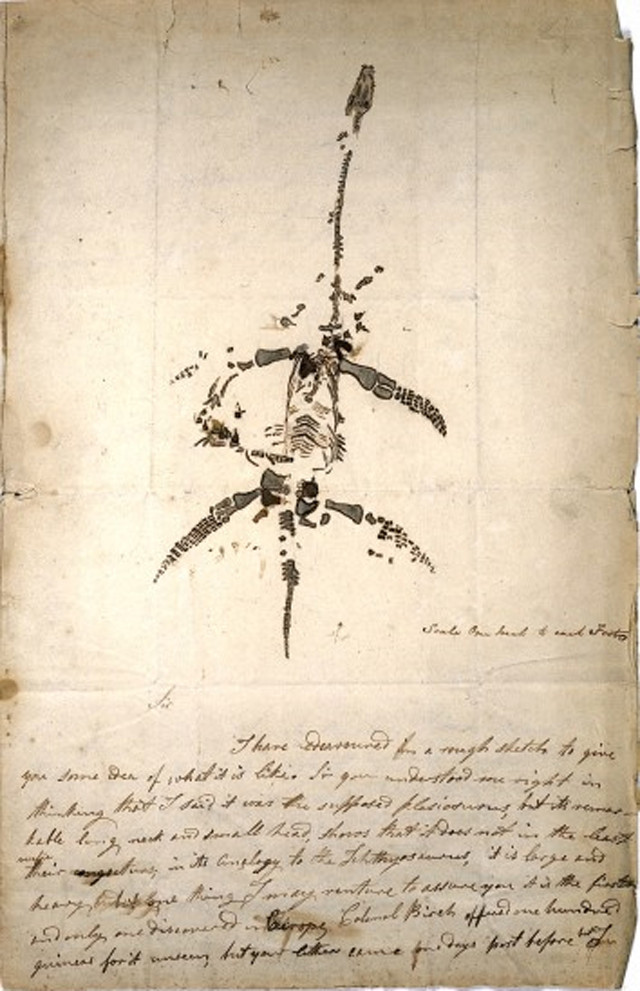
by Ward Chesworth Friday, February 5, 2016

Autograph letter concerning the discovery of plesiosaurus, from Mary Anning. Credit: public domain.
For me there were two notable events in 1847. One was literary, the other scientific. The literary event was the publication of the first Harlequin Romance, more than a century before Harlequin Romances actually existed. It followed the usual formula in which a shy, self-effacing girl goes to work for a domineering, untamed hunk of a man, falls in love with him and, after a convenient house fire rids him of the mad wife he kept stashed in the attic, he surrenders. In the final chapter of Charlotte Bronte’s “Jane Eyre” the heroine announces, “Reader, I married him.”
The notable scientific event was the death of Mary Anning, the first great female “fossilist” — the term used before “paleontologist” became common. Mary’s life of 47 years was spent in and around Lyme Regis, at the foot of the cliffs of Jurassic rock on the coast of the English Channel there. Being female, poor and a religious dissenter, she was denied a formal education, although she and her brother learned a little at least from their father, a carpenter who supplemented the family income by collecting and selling fossils. Mary was academically inclined and went on to teach herself enough geology and anatomy to become a paleontologist in all but name. She was 12 years old when she painstakingly excavated a “crocodile” that her brother had found, and which was later named the world’s first ichthyosaur (that’s “fish-lizard” in paleo-speak).
Just out of her teens, she discovered the partial skeleton of a second world’s-first — another marine reptile, though one more reptilian than the ichthyosaur. Plesiosaur (or “near-lizard”) became its name. Later, she excavated other plesiosaurs, including the one that defines the genus. Louis Agassiz of Harvard’s Museum of Comparative Zoology named two fossil fishes after Mary — a rare contemporary recognition of her contributions to science. She was finally called a geologist in a biography published 78 years after her death from breast cancer. In 2010, a panel of the Royal Society of London named her one of the 10 most influential women in British science. Largely because of her and the dinosaurs she discovered, her part of England is now called the Jurassic Coast as a kind of “come hither” to tourists. It helps of course that Michael Crichton made the Jurassic the sexiest period in the stratigraphic column.
The cliffs around Lyme Regis where Mary collected are at the southern end of a band of Jurassic rocks that can be followed diagonally across England for almost 500 kilometers, forming the Cotswold Hills along the way to its final destination on a second Jurassic Coast where the North Sea confronts Yorkshire. For my generation of alumni of Manchester University’s Department of Geology, this second Jurassic Coast is associated with a charismatic teacher of paleontology named Fred Broadhurst. Fred was a “Bevin Boy,” who chose as a teenager to do his national service working in a coal mine. When he went on to become a paleontologist he wrote his doctoral thesis on the nonmarine lamellibranchs he found in the mine. I was arguably Fred’s least-attentive student, being more interested in a female botanist in the class, but his enthusiastic, colorful lecturing style carried me through to a passing grade. When I became an academic myself, I discovered that I had learned a great deal from Fred’s example, and consciously adapted his teaching technique as my own.
In 1960, Fred took his undergrad class to the second Jurassic Coast. Below the beetling cliffs of Robin Hood’s Bay near Whitby, one of the students hammered off a knob of rock and brought it to be identified. Fred and his assistant Jas Potts agreed that it was vertebrate bone and later confirmed that a large Jurassic reptile lay buried in the tidal zone. Fred obtained funding to return to the coast to excavate the fossil and bring it to his lab. I was a geochemistry graduate student by then, but managed to insinuate myself into his party of six volunteer laborers. For two days, from dawn to dusk, we worked between tides to excavate blocks of the Jurassic. We then dragged the blocks up ladders to the cliff top and headed back to Manchester.
After cleaning and trimming away unwanted rock, the 4.3-meter-long fossil was reassembled like a jigsaw puzzle. What emerged was one of the most complete plesiosaurs ever discovered, and a new species, Hauffiosaurus tomistomimus, was born. In 2012, after decades in a glass case in the geology department, “Percy the Plesiosaur” was moved across the road and placed in a new display at the University of Manchester Museum.
You may be wondering what happened to the botanist who diverted my attention from Fred’s fossils in his paleontology class. Reader, I married her.
© 2008-2021. All rights reserved. Any copying, redistribution or retransmission of any of the contents of this service without the expressed written permission of the American Geosciences Institute is expressly prohibited. Click here for all copyright requests.